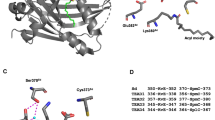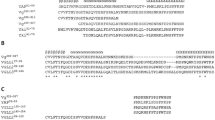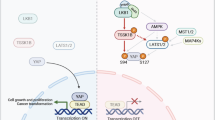Abstract
The co-activator Yorkie (Yki) mediates transcriptional regulation effected by the Drosophila Fat–Warts (Wts)–Hippo (Hpo) pathways. Yki is inhibited by Wts-mediated phosphorylation, and a Wts phosphorylation site at Ser168 has been identified. Here we identify two additional Wts phosphorylation sites on Yki, and examine the respective contribution of all three sites to Yki nuclear localization and activity. Our results show that although Ser168 is the most critical site, all three phosphorylation sites influence Yki localization and activity in vivo, and can be sites of regulation by Wts. Thus, investigations of the role of Yki and its mammalian homolog Yes-associated protein (YAP) in development and oncogenesis should include evaluations of additional sites. The WW domains of Yki are not required for its phosphorylation, but instead are positively required for its activity. We also identify two potential sites of phosphorylation by an unknown kinase, which could influence phosphorylation of Ser168 by Wts, suggesting that there are additional mechanisms for regulating Yki/YAP activity.
This is a preview of subscription content, access via your institution
Access options
Subscribe to this journal
Receive 50 print issues and online access
$259.00 per year
only $5.18 per issue
Buy this article
- Purchase on Springer Link
- Instant access to full article PDF
Prices may be subject to local taxes which are calculated during checkout







Similar content being viewed by others
References
Basu S, Totty NF, Irwin MS, Sudol M, Downward J . (2003). Akt phosphorylates the Yes-associated protein, YAP, to induce interaction with 14-3-3 and attenuation of p73-mediated apoptosis. Mol Cell 11: 11–23.
Dong J, Feldmann G, Huang J, Wu S, Zhang N, Comerford SA et al. (2007). Elucidation of a universal size-control mechanism in Drosophila and mammals. Cell 130: 1120–1133.
Fu H, Subramanian RR, Masters SC . (2000). 14-3-3 proteins: structure, function, and regulation. Annu Rev Pharmacol Toxicol 40: 617–647.
Goulev Y, Fauny JD, Gonzalez-Marti B, Flagiello D, Silber J, Zider A . (2008). SCALLOPED interacts with YORKIE, the nuclear effector of the hippo tumor-suppressor pathway in Drosophila. Curr Biol 18: 435–441.
Groth AC, Fish M, Nusse R, Calos MP . (2004). Construction of transgenic Drosophila by using the site-specific integrase from phage phiC31. Genetics 166: 1775–1782.
Hao Y, Chun A, Cheung K, Rashidi B, Yang X . (2008). Tumor Suppressor LATS1 Is a Negative Regulator of Oncogene YAP. J Biol Chem 283: 5496–5509.
Huang J, Wu S, Barrera J, Matthews K, Pan D . (2005). The Hippo signaling pathway coordinately regulates cell proliferation and apoptosis by inactivating Yorkie, the Drosophila Homolog of YAP. Cell 122: 421–434.
Kinoshita E, Kinoshita-Kikuta E, Takiyama K, Koike T . (2006). Phosphate-binding tag, a new tool to visualize phosphorylated proteins. Mol Cell Proteomics 5: 749–757.
Lee T, Luo L . (2001). Mosaic analysis with a repressible cell marker (MARCM) for Drosophila neural development. Trends Neurosci 24: 251–254.
Mackintosh C . (2004). Dynamic interactions between 14-3-3 proteins and phosphoproteins regulate diverse cellular processes. Biochem J 381: 329–342.
Oh H, Irvine KD . (2008). in vivo regulation of Yorkie phosphorylation and localization. Development 135: 1081–1088.
Reddy BV, Irvine KD . (2008). The Fat and Warts signaling pathways: new insights into their regulation, mechanism and conservation. Development 135: 2827–2838.
Steinhardt AA, Gayyed MF, Klein AP, Dong J, Maitra A, Pan D et al. (2008). Expression of Yes-associated protein in common solid tumors. Hum Pathol 39: 1582–1589.
Vidal M, Cagan RL . (2006). Drosophila models for cancer research. Curr Opin Genet Dev 16: 10–16.
Wu S, Liu Y, Zheng Y, Dong J, Pan D . (2008). The TEAD/TEF family protein Scalloped mediates transcriptional output of the Hippo growth-regulatory pathway. Dev Cell 14: 388–398.
Zender L, Spector MS, Xue W, Flemming P, Cordon-Cardo C, Silke J et al. (2006). Identification and validation of oncogenes in liver cancer using an integrative oncogenomic approach. Cell 125: 1253–1267.
Zeng Q, Hong W . (2008). The emerging role of the hippo pathway in cell contact inhibition, organ size control, and cancer development in mammals. Cancer Cell 13: 188–192.
Zhang L, Ren F, Zhang Q, Chen Y, Wang B, Jiang J . (2008). The TEAD/TEF family of transcription factor Scalloped mediates Hippo signaling in organ size control. Dev Cell 14: 377–387.
Zhao B, Wei X, Li W, Udan RS, Yang Q, Kim J et al. (2007). Inactivation of YAP oncoprotein by the Hippo pathway is involved in cell contact inhibition and tissue growth control. Genes Dev 21: 2747–2761.
Zhao B, Ye X, Yu J, Li L, Li W, Li S et al. (2008). TEAD mediates YAP-dependent gene induction and growth control. Genes Dev 22: 1962–1971.
Acknowledgements
We thank P Beachy, D Pan, J Jiang, G Halder and the Bloomington Drosophila Stock Center for antibodies, plasmids and Drosophila stocks, and C Rauskolb for comments on the paper. This research was supported by the Howard Hughes Medical Institute and NIH post-doctoral fellowship 1F32GM079817 to HO.
Author information
Authors and Affiliations
Corresponding author
Additional information
Supplementary Information accompanies the paper on the Oncogene website (http://www.nature.com/onc)
Supplementary information
Rights and permissions
About this article
Cite this article
Oh, H., Irvine, K. In vivo analysis of Yorkie phosphorylation sites. Oncogene 28, 1916–1927 (2009). https://doi.org/10.1038/onc.2009.43
Received:
Revised:
Accepted:
Published:
Issue Date:
DOI: https://doi.org/10.1038/onc.2009.43
Keywords
This article is cited by
-
Shaggy regulates tissue growth through Hippo pathway in Drosophila
Science China Life Sciences (2022)
-
Hippo signaling suppresses tumor cell metastasis via a Yki-Src42A positive feedback loop
Cell Death & Disease (2021)
-
Suppression of Patronin deficiency by altered Hippo signaling in Drosophila organ development
Cell Death & Differentiation (2021)
-
PMEPA1 isoform a drives progression of glioblastoma by promoting protein degradation of the Hippo pathway kinase LATS1
Oncogene (2020)
-
Usp7 regulates Hippo pathway through deubiquitinating the transcriptional coactivator Yorkie
Nature Communications (2019)



